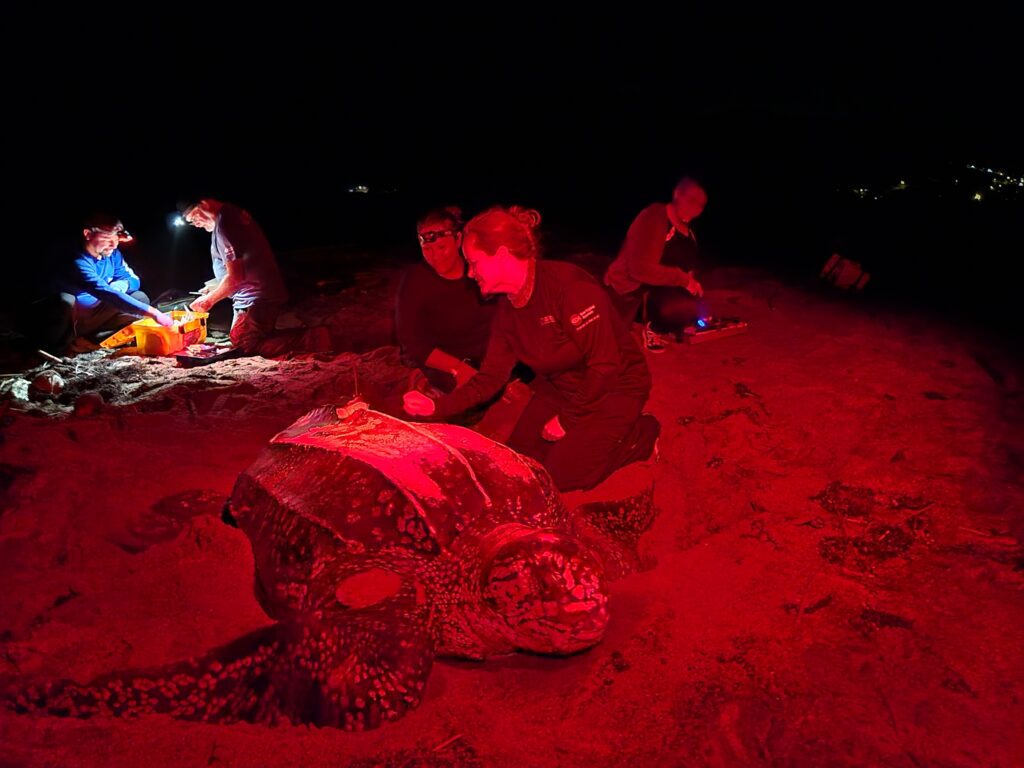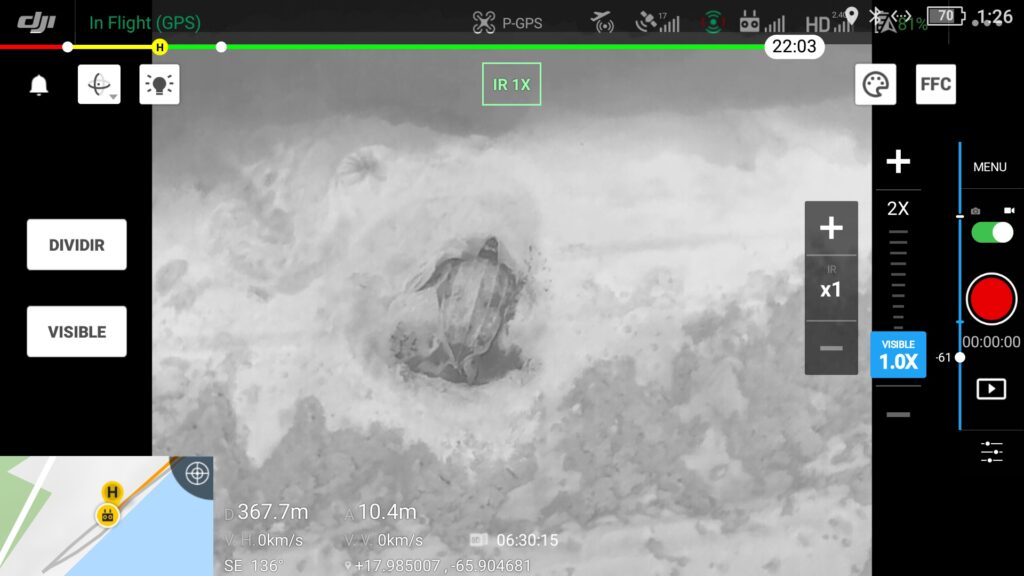New England Aquarium providing funding, expertise to support leatherback sea turtle conservation and recovery efforts

BOSTON, MASS. (June 15, 2023) – Using cutting-edge drone technology and satellite tagging, researchers are protecting endangered leatherback sea turtles in Puerto Rico with the help of expertise and funding from the New England Aquarium.
**PHOTOS AND VIDEO AVAILABLE HERE. CREDIT NEW ENGLAND AQUARIUM, UNLESS NOTED**
Leatherback sea turtles in the United States are an endangered species. These turtles are particularly challenging to monitor as they can make extensive migrations across entire ocean basins, travelling over 60 kilometers per day. In 2018, Dr. Kara Dodge, a research scientist with the Aquarium’s Anderson Cabot Center for Ocean Life, began collaborating with the organization Amigos de las Tortugas Marinas (ATMAR) after a leatherback turtle tagged off Cape Cod turned up in Puerto Rico. Dr. Dodge studies the behavior of leatherback turtles, focusing on gathering data using innovative tools and techniques—including satellite tagging—to support conservation and recovery efforts for this endangered species.
Dr. Dodge has traveled down to Puerto Rico over the past several years, working with the Puerto Rico Department of Natural and Environmental Resources (DRNA) and ATMAR to establish the first long-term satellite tagging project for leatherbacks in southeast Puerto Rico. The team collects data on inter-nesting habitats (where leatherbacks swim between nesting events), identifies nesting beaches outside of monitored areas, detects dispersal to other island beaches, and tracks the post-nesting migrations of turtles to their northern foraging areas.
“Leatherbacks in Puerto Rico currently have no critical habitat protections. There is almost no data to set those boundaries for coastal waters near important leatherback nesting beaches. The New England Aquarium is working with DRNA and ATMAR to collect this data, which can be used to protect leatherbacks during their critical breeding and nesting period,” said Dr. Dodge.
This past May, Dr. Dodge traveled to Puerto Rico for seven days with a team of biologists from the Aquarium to work with ATMAR. The team applied five satellite tags to nesting leatherback turtles on Playa California in Maunabo, located in the southeastern end of the island.
ATMAR Founder and President Luis Crespo uses drone technology to monitor the beach at night. The drone has a thermal camera and a visual camera that allows the scientists to efficiently search for the presence of leatherbacks, allowing the research team to reach the turtles quickly once sighted. Time is particularly important as the team only has a 10-minute window to apply the tags while a turtle lays her eggs. The two-kilometer beach needs to be monitored every hour, and the drone takes just 10 to 15 minutes to sweep the area. The camera’s resolution allows scientists to collect detailed information at an altitude that does not disturb the turtles, such as tracks in the sand, how far along the turtle is in her nesting process, and even small metal flipper tags on her rear flippers.
“The drone is an amazing tool. It records both visual and infrared video simultaneously and allows us to spot the animals as they come out of the water,” Crespo said. “We are looking not only for the leatherbacks but nest predators, such as feral dogs or poachers.”

ATMAR has been working for more than 22 years to prevent poaching of leatherback nests, protect the turtles and their eggs, as well as educate the local community about sea turtle conservation issues. The organization’s work has eliminated poaching on the main nesting beaches in Maunabo, thanks to regular patrols by ATMAR volunteers during leatherback nesting season.
The Aquarium’s Marine Conservation Action Fund (MCAF) provided the funding for ATMAR to acquire the drone. MCAF is a microgranting and fellowship program that addresses critical needs in the marine conservation field. The program supports conservation leaders gathering key data on imperiled ocean animals and engaging communities through conservation projects. These leaders are then equipped to create solutions that benefit ocean health as well as the livelihoods of local communities.
Data is already being transmitted from the turtles’ satellite tags. This season, the research team tagged two turtles that had been tagged previously in 2021, “Carmen” and “Noemi,” providing an opportunity to compare data from multiple years. Since satellite tags typically last for a year or less, this was a rare opportunity to collect multi-year data on individual turtles.
Leatherback turtle populations in the North Atlantic are undergoing dramatic and widespread nesting beach declines, at a rate of 4% per year. This reflects an overall global trend of leatherback decline in all ocean basins. The Northern Caribbean population, which is made up of leatherbacks from Puerto Rico and St. Croix, U.S. Virgin Islands, has been declining steadily since 2009. While the nesting population in Maunabo has remained relatively stable and one of the most important nesting beaches in Puerto Rico, this season marked a low year with only 150 nests so far; in previous years, a low number was closer to 200. Scientists hope their tagging efforts will help explain these changing numbers and identify potential threats.
Leatherback research activities in Maunabo were authorized under DRNA Permit #2023-EPE-016.
MEDIA CONTACT:
Pam Bechtold Snyder – psnyder@neaq.org, 617-686-5068
